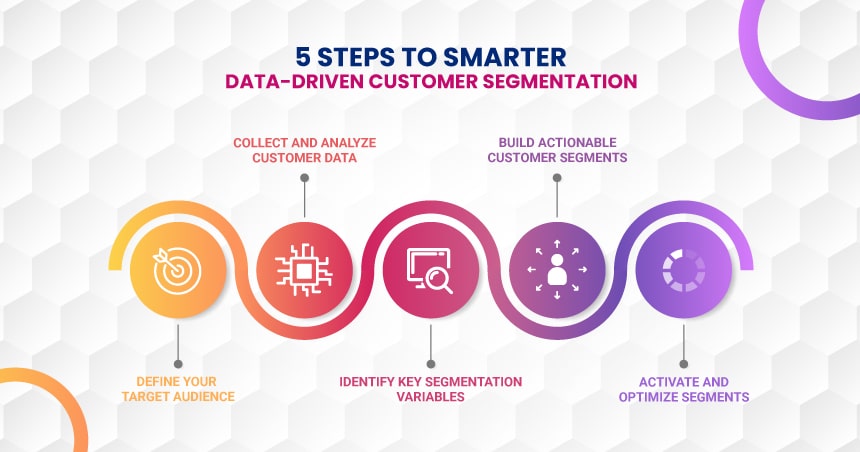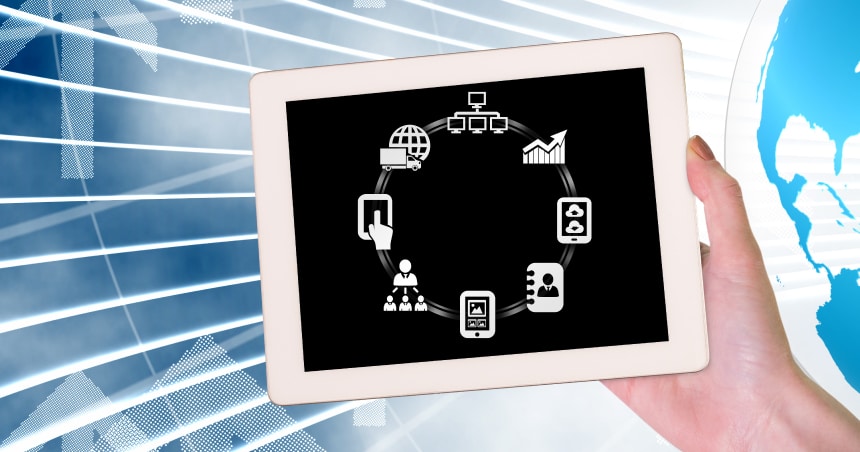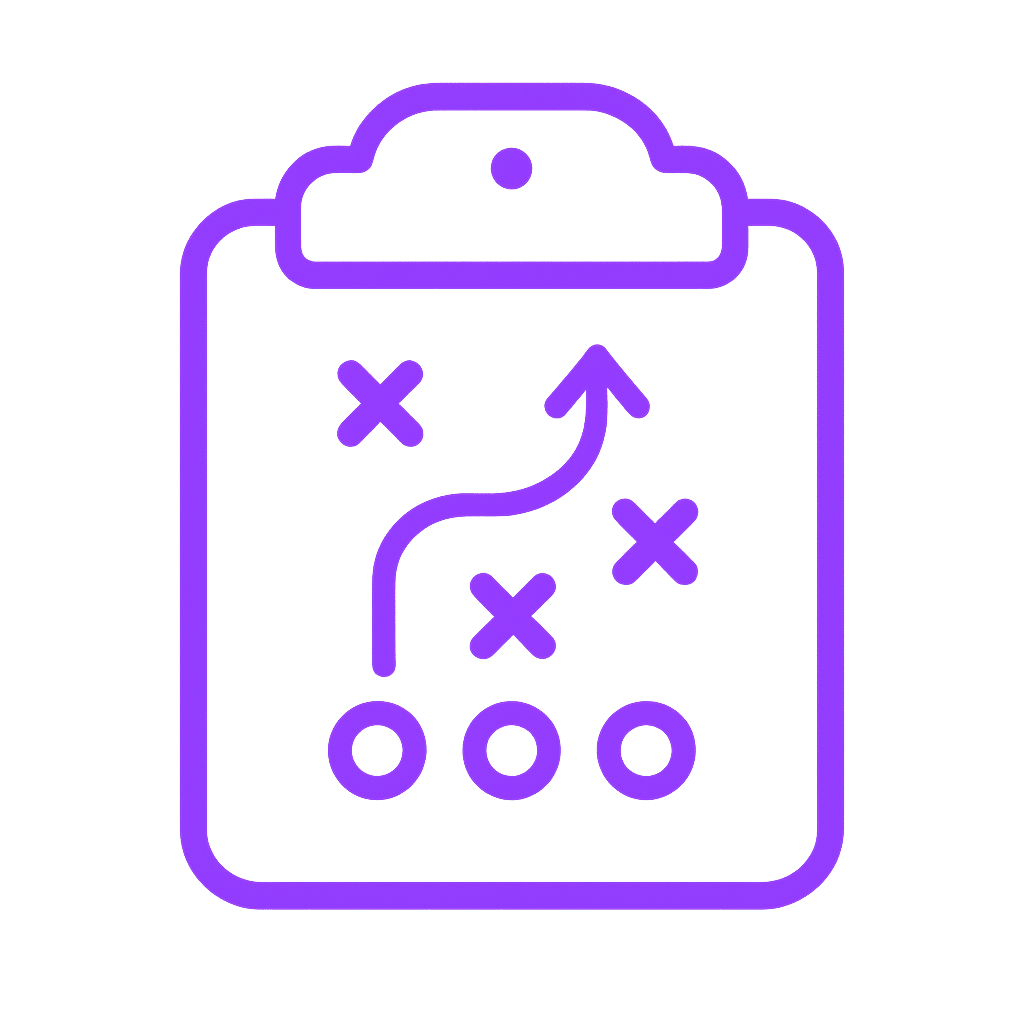
Table of Contents
- Customer Segmentation: An Overview
- Why Customer Segmentation Matters
- 5 Steps to Smarter, Data-Driven Customer Segmentation
- How AI Powers Smarter Customer Segmentation
- ImpelHub's AI-Powered Customer Segmentation Process
- How ImpelHub Transforms Segmentation
- ICP Definition: Evidence-Based, Not Assumption-Driven
- ICP Rating: Strategic Prioritization Through 10-Grade Assessment
- Strategic Focus on Top-Performing ICPs
- AI Segmentation with ImpelHub
Customer Segmentation: An Overview
When I first introduced segmentation at my former employer, we were astounded by how different customer groups reacted to the same messaging differently. What was excellent for one segment was ineffective for another. When our marketing director saw how our 55+ demographic interacted with content that our 25-34 group ignored, she almost lost her mind. I realized then that treating every customer the same way is like using a sledgehammer when you need a scalpel. But it is tiring and labor-intensive.
Customer segmentation breaks up a large customer base into smaller, more focused groups based on shared traits such as demographics, behavior, needs, or preferences. By understanding these segments and customizing their marketing strategies, goods, and services, businesses can better meet the specific needs of each group. This leads to more individualized interactions, increased engagement, and improved customer satisfaction in general.
Expert-led AI platform for Growth Strategies and execution Plans, like ImpelHub, transforms segmentation from a laborious, manual process into a competitive advantage. By using artificial intelligence to uncover insights, spot trends, and create customized strategies, ImpelHub removes the uncertainty that impedes growth.
Why Customer Segmentation Matters
According to recent McKinsey & Company research, businesses that successfully use segmentation see revenue growth 10-15% higher than those that use generic marketing strategies. With AI tools like Insight360 and FanScope, segmentation has become easier, allowing companies to forecast customer needs more accurately and spot trends.
Are you prepared to modify your strategy and expand your company? Let’s dissect it in detail.

5 Steps to Smarter, Data-Driven Customer Segmentation
Step 1: Define Your Goal and Target Audience

Start by clarifying your goals. Are you looking to improve retention, boost revenue, or refine product development? Your segmentation strategy should align with these objectives. For example, if increasing customer lifetime value is your focus, you’ll want to identify high-value customers and understand what makes them tick.
I’ve found that writing down these goals somewhere visible – maybe on a post-it note stuck to your monitor – helps keep you focused when you’re knee-deep in data later on. Last year, I worked with a client who kept getting distracted by interesting but irrelevant data points. We finally wrote “REDUCE CHURN BY 15%” in big red letters on a whiteboard in their office. Someone would point to the board whenever the conversation drifted, and we’d get back on track.
Before diving into analytics, you need clarity on who delivers the most value to your business. Building comprehensive customer profiles requires integrating multiple data dimensions.
Comprehensive Customer Data Types for Strategic Segmentation
Data Type | Description | Real-World Example | Business Impact |
|---|---|---|---|
Demographic | Beyond basic age and gender metrics, it includes income distribution, education levels, and occupational patterns | Luxury vs. Mass Market: Rolex targets high-income individuals ($250,000+ annual income) with premium pricing, while Target focuses on middle-income households ($50,000-$100,000) | Pew Research found that 80% of U.S. adults aged 18–49 shop online at least once a month—a critical insight for digital strategy development |
Geographic | Location intelligence reveals behavioral variations based on where customers live | Urban vs. Rural Marketing: Starbucks’ urban locations emphasize quick service and mobile ordering, while their rural locations highlight community gathering spaces | McKinsey research demonstrates that consumer preferences and purchasing frequency differ dramatically between urban and rural markets, directly impacting distribution and messaging strategies. |
Psychographic | Understanding customers’ values, interests, and personality traits | Value-Based Segmentation: Whole Foods targets health-conscious consumers willing to pay premium prices, while Aldi targets price-sensitive shoppers who prioritize value | Companies like Patagonia have built billion-dollar businesses by targeting environmentally conscious consumers with aligned messaging. |
Behavioral | Your most valuable intelligence – purchase history, frequency, product usage, and brand interactions | Frequency vs. Recency: Amazon Prime members shop on average 2.3x more frequently than non-Prime customers, making frequency a stronger predictor of lifetime value than recency | Bain & Company research shows that increasing customer retention by just 5% can increase profits by 25% to 95%. |
Lifestyle | Bridges the gap between stated values and actual behaviors | Aspirational vs. Actual Behavior: While 65% of consumers claim environmental concerns influence their purchasing, only 26% consistently buy eco-friendly products | Peloton successfully targets fitness enthusiasts who value convenience. Their data shows that 92% of their customers previously had gym memberships but used them less than twice a month. |
Note: This matrix helps marketers align segmentation type with their targeting goals. ImpelHub uses AI to streamline this process by auto-detecting and updating real-time segments.
Once you have set the goal, start by strategically examining your current customer base: Who drives the most revenue? Who demonstrates the highest retention rates? Which profiles align with your long-term business objectives? This foundational understanding will guide every subsequent decision.
This understanding lets you connect with customers more deeply, beyond just the transaction.
Step 2: Collect and Analyze Customer Data
According to Salesforce, 66% of customers expect companies to understand their unique needs and expectations. This level of understanding requires accurate, unified, and actionable data.
The trickiest part is balancing the desire for comprehensive data with the practical limitations of what you can collect and analyze. Sometimes, less is more—focus on quality over quantity. I once watched a marketing team spend three months building an elaborate data collection system, only to end up with so much information they couldn’t understand. They would have been better off starting with three key metrics and expanding gradually.
To effectively segment your audience, you’ll need to gather data from multiple sources:
- CRM systems (customer profiles and sales history)
- Website analytics (user behavior and traffic patterns)
- Email campaign metrics (engagement and conversion data)
- E-commerce transaction data (order value, cart abandonment, purchase frequency)
- Social media engagement (sentiment analysis and brand perception)
- Customer feedback (voice of customer, support tickets, satisfaction scores)
Step 3: Identify Key Segmentation Variables
With comprehensive data in place, the next step is identifying patterns that drive business value. This is where behavioral segmentation delivers exceptional ROI.

Key Behavioral Segmentation Variables
Variable | Description | Strategic Application | Performance Metrics |
|---|---|---|---|
Purchase Frequency | How often do customers make purchases within a specific timeframe | Identify loyal customers who buy regularly; segment into cohorts like “weekly shoppers,” “monthly buyers,” or “occasional purchasers”; develop targeted retention strategies | Subscription businesses discover that customers making additional purchases beyond their subscription in the first 60 days have 3x higher lifetime value |
Churn Risk | Predictive analytics to identify customers showing signs they might discontinue their relationship | Implement proactive retention campaigns before customers fully disengage; identify early warning signals like declining engagement, reduced usage, increased support tickets | Reducing churn by just 5% can increase profitability by 25-95% according to Bain & Company research |
Engagement Levels | How customers interact with your brand across all available channels | Identify which customers are most invested in your brand ecosystem; tailor communication frequency and content based on engagement patterns | Omnichannel retailers discover that customers who engage across three or more channels spend 250% more than single-channel customers |
Customer Journey Stage | Customer’s progression through the relationship lifecycle | Customize messaging and offers based on where customers are in their journey; allocate resources to move customers through the funnel | B2B companies learn that prospects who download specific technical whitepapers are 4x more likely to convert to paying customers |
Product Preference | Which products, categories, or features do customers gravitate toward | Enable highly personalized recommendations and targeted product development; identify cross-selling opportunities | E-commerce companies discover that customers who first purchase from a specific category have distinct cross-selling opportunities with 60% higher conversion rates |
Note: Behavioral segmentation is just one piece of the puzzle. Demographic, geographic, psychographic, lifestyle, and firmographic variables are critical in crafting a complete customer profile.
Do you need help choosing the right segmentation strategy for your business? We can provide examples tailored to your goals and industry!
These insights enable highly personalized recommendations and targeted product development. For example, an e-commerce company might discover that customers who first purchase from a specific category have cross-selling opportunities with 60% higher conversion rates.
A 2023 Segment report revealed that companies leveraging advanced segmentation are 2.3x more likely to exceed ROI goals. Advanced techniques like clustering algorithms, decision trees, and predictive modeling uncover hidden relationships within your data.
Step 4: Build Actionable Customer Segments

Translating variables into usable customer groups requires strategic discipline.
Key Criteria for Defining Effective Customer Segments
Criterion | Description | Real-World Application |
|---|---|---|
Clear Differences Between Groups | Each segment should have unique characteristics that drive differentiated messaging and offerings | A B2B SaaS platform segments small businesses focused on affordability separately from enterprise clients requiring robust integrations and support, each with fundamentally different expectations |
Measurable and Quantifiable | Every segment must be measurable through reliable metrics | An online retailer tracks how a “high-LTV” segment behaves—their purchase frequency, category preferences, and basket size—to inform inventory and marketing decisions |
Substantial Size | Each group needs to be large enough to justify specific attention | A niche product company identifies that their “enthusiast” segment, while only 15% of customers, drives 40% of revenue, making them worth specialized marketing |
Actionable | You should be able to create targeted strategies for each group | A software company develops different onboarding sequences for technical vs. non-technical users based on precise segmentation data |
Accessible | Your marketing efforts must be able to reach these groups effectively | A fitness app identifies tech-savvy Gen Z users who respond well to influencer marketing on TikTok, making that segment highly accessible through specific platforms |
Responsive | Groups should react differently to various marketing tactics | A luxury brand finds that its high-income professional segment responds to exclusivity messaging, while its aspirational segment responds to financing options |
Financially Viable | The value generated should significantly outweigh acquisition and service costs. | A luxury brand might find that targeting middle-income shoppers yields low conversion and high ad spend, while high-income professionals deliver superior ROI through frequent high-ticket purchases. |
Each segment should have unique characteristics that drive differentiated messaging and offerings. For example, a B2B SaaS platform might segment small businesses focused on affordability separately from enterprise clients requiring robust integrations and support, each with fundamentally different expectations and purchasing behaviors.
Every segment must be measurable through reliable metrics, including engagement, conversion rates, average order value, and retention. Without quantifiable data, it’s impossible to justify investments or optimize strategies. To inform inventory and marketing decisions, an online retailer can track how a “high-LTV” segment behaves regarding their purchase frequency, category preferences, and basket size.
Segments must be reachable through targeted campaigns across appropriate channels. If you can’t effectively connect with a segment due to limited contact data or channel access, it’s not viable for marketing activation. A fitness app might identify tech-savvy Gen Z users who respond well to influencer marketing on TikTok, making that segment highly accessible through specific platforms.
Even if a segment is measurable and accessible, it must deliver strong investment returns. The value generated through purchases, subscriptions, or referrals should significantly outweigh acquisition and service costs. A luxury brand might find that targeting middle-income shoppers yields low conversion and high ad spend, while high-income professionals, though fewer in number, deliver superior ROI through frequent high-ticket purchases.
Creating Detailed Customer Profiles
Creating detailed customer profiles helps you understand each segment better.
Don’t be afraid to get creative here. Giving each segment a name and creating fictional personas can help your team better understand and connect with each group. Designing marketing for “Busy Professional Pam” is much easier than designing “Segment B-2.”
Profile Element | Key Details | Example |
|---|---|---|
Demographics | Basic traits and characteristics | B2B tech buyers, age 35-45, $150,000+ annual income |
Pain Points | Challenges and needs | Struggling with data security, need automated solutions |
Goals | Objectives and aspirations | Reduce operational costs by 25%, improve efficiency |
Buying Behavior | Purchase patterns and preferences | Research-driven, 3-month sales cycle, committee decisions |
Communication | Preferred channels and style | Professional email, LinkedIn, technical whitepapers |
Map Customer Group Priorities
Identify what drives each segment and focus on these areas:
- Is it Product Features? If yes, what matters most to them?
- What level of support do they expect?
- How do they weigh cost versus value?
- What influences their buying choices?
“At its core, segmentation allows us to meet customers where they are in their buying journey, tailoring our communication and support to drive satisfaction and loyalty.” – Windy Pierre, eCommerce Growth Marketer
Once you’ve outlined these priorities, you can turn them into actionable strategies.
Plan Next Actions
Segmentation insights are only powerful if they lead to meaningful action. For example, ImpelHub’s NextMove takes you from insights to execution, helping you plan, prioritize, and act on the core pillars of growth.
1. Strategy Alignment
Ensure your tactics are targeted, realistic, and results-driven.
- Match campaigns and offers to each segment’s characteristics.
- Align actions with overall business goals and growth priorities.
- Assess required resources, ownership, and implementation timelines
Example: For a segment of “at-risk users,” NextMove might recommend launching a 14-day win-back email series, flagging CRM and design resources needed for deployment.
2. Content Planning
Deliver the right message to the right audience, at the right time.
- Build unique messaging themes for each customer segment.
- Create targeted content calendars aligned with the buyer journey.s
- Plan distribution across email, web, social, and paid channels
Example: For “first-time buyers,” NextMove could suggest an onboarding content track with weekly educational emails and product tutorials.
3. Execution Framework
Track what matters and pivot when needed.
- Define KPIs tied to each campaign or initiative.
- Set up dashboards and alerts to monitor performance in real time.
- Schedule regular reviews to optimize and adapt based on results.
Example: For a loyalty campaign, you might track repeat purchase rate, engagement with loyalty emails, and more.
Need help building your NextMove plan?
Let us walk you through how ImpelHub transforms segmentation into revenue-generating action.
Implementing AI in B2B Sales Organizations
With well-defined segments established, the focus shifts to activation across channels:
Align Marketing with Customer Groups
Focus your marketing efforts on specific customer segments. Tools like ImpelHub’s NextMove can help you craft messages that resonate with each group. By tailoring your communication, you can better address their needs and deliver measurable outcomes. This approach also creates opportunities for constant improvement and fine-tuning.
I’ve seen too many businesses put tremendous effort into creating detailed segments, only to continue sending the same generic marketing to everyone. Don’t fall into this trap! The real value comes when you use your segments to differentiate your approach.
A few years back, I consulted for a company that had spent months developing sophisticated customer segments. They had beautiful presentations about each group’s characteristics and needs. But when I asked how they used these insights in their marketing, there was an awkward silence. All that work sat in a PowerPoint deck while their campaigns remained one-size-fits-all. What a waste!
Here’s how to put your segments to work:
- Personalize email campaigns with segment-specific messaging
- Customize website experiences based on visitor segments
- Tailor product recommendations to segment behavior
- Create targeted advertising for specific personas
- Develop segment-specific content strategies
Keep Segments Updated
Customer behavior isn’t static, and neither should your segmentation strategy. Use the detailed profiles you’ve built to adapt and refine segments as new insights emerge. ImpelHub can help you track these behaviors in real time and make necessary adjustments.
Regular Reviews: Set a schedule to review your segments weekly and evaluate them quarterly. Pay attention to shifts in purchase habits, engagement trends, campaign responses, and customer feedback.
Refinement: Use tools like ImpelHub’s FanScope to analyze new patterns in customer behavior. Whether due to product launches, market changes, seasonal trends, or shifts in customer lifecycles, updating your segments ensures they stay relevant and actionable.
A/B testing becomes essential at this stage. Experiment with messages, formats, and offers while continuously tracking performance metrics to refine your approach.
How AI Powers Smarter Customer Segmentation

Artificial intelligence is revolutionizing customer segmentation by making the process faster, more accurate, and highly actionable. It enables businesses to uncover deeper insights, identify high-value audience groups, and personalize experiences at scale, all with minimal manual effort.
AI Capability | Description | Business Impact |
|---|---|---|
Unified Data Ingestion | It automatically collects and integrates customer data from diverse sources, cleaning, enriching, and structuring it in real time. | Creates a comprehensive customer profile foundation essential for meaningful segmentation. |
Pattern Detection and Clustering | Uses sophisticated machine learning models to identify hidden patterns across millions of data points. | Surfaces opportunities like high-intent mobile users who frequently abandon carts on weekends, enabling precisely timed retargeting. |
Intelligent Scoring and Prioritization | Scores and ranks customers based on key metrics, including predicted lifetime value, churn risk, and conversion likelihood. | It enables businesses to focus resources on the highest-impact segments, whether loyal customers, at-risk users, or emerging buyer personas. |
Strategy Generation and Automation | Generates tailored strategies for each group, including automated email workflows, product recommendations, and landing page content. | Teams receive dynamic, real-time guidance customized to each segment’s behavior and preferences. |
Continuous Learning and Optimization | Continuously refines segments, detects shifts, and adjusts strategies accordingly. | Ensures segmentation remains relevant and aligned with business objectives as customer behavior evolves. |
Learn how ImpelHub helps you build smarter segments and more innovative strategies.
ImpelHub's AI-Powered Customer Segmentation Process
Not all customers deliver equal value. Some represent perfect alignment with your business model, while others consume resources without generating adequate returns. This reality drives ImpelHub’s focus on Ideal Customer Profiles (ICPs), the foundation of strategic segmentation.
What Makes an Ideal Customer Profile?
An ICP represents your optimal customer—one who:
- Derives exceptional value from your product or service
- Demonstrates high retention and loyalty
- Contributes significantly to business growth and profitability
ImpelHub’s approach is designed to precisely identify these high-value ICPs, eliminating wasted resources on poor-fit prospects.
How ImpelHub Transforms Segmentation
Traditional segmentation often relies on static demographics or simplistic firmographics. ImpelHub takes a fundamentally different approach; it is data-driven, dynamic, and strategically aligned with business outcomes.
The process began with an “Intake Survey,” which captured the stage, goals, and challenges. This was followed by a “Insight 360” and “Insight 360+” deep dive into their business and the broader industry. Then, FanScope identified potential direct and indirect buyers to help with ICP creation.
FanScope
FanScope serves as the intelligence core of ImpelHub’s segmentation methodology. It analyzes a sophisticated combination of signals:
- Customer behaviors and purchasing patterns
- Cross-channel engagement metrics
- Competitive positioning and market dynamics
- Opportunity gaps
- Lifestyle indicators and preference signals
FanScope identifies your true fans through this multidimensional lens—segments demonstrating strong intent, loyalty, and brand alignment. It answers critical strategic questions like:
- Which customer types are already resonating with your offering?
- What segments show engagement without conversion?
- Where are you gaining or losing competitive advantage?
This discovery process establishes the foundation for precision targeting.
ICP Definition: Evidence-Based, Not Assumption-Driven
With FanScope insights as the foundation, ImpelHub helps organizations define or refine their ideal customer profiles. These ICPs transcend traditional “educated guesses” based on company size or budget. Instead, they’re constructed using
- Actual engagement and conversion data
- Purchase intent analysis
- Strategic gaps in the competitive landscape
- Internal capability alignment
This results in a validated, high-resolution profile of your best-fit customers, characterized by:
- Demographic and psychographic details
- Decision Maker or Buyer Profile
- Specific pain points and challenges
- Goals and aspirations
- Product/service requirements
- Buying behavior patterns
- Technology preferences
- Lifestyle attributes
ICP Rating: Strategic Prioritization Through 10-Grade Assessment
Defining ICPs is only the beginning. ImpelHub’s methodology includes a comprehensive 10-grade assessment system for rating and prioritizing segments across key strategic dimensions.
1
How significant and urgent is the problem this segment faces?
2
How much better is our product/service compared to alternatives for this segment?
3
How easily can we reach and engage this segment?
4
Does this segment align with our total addressable market and revenue focus?
5
How well does this segment align with our mission and long-term business goals?
6
What is the revenue and margin potential of this segment?
7
How quickly can this segment adopt our product or service?
8
What is the likelihood of long-term retention and customer loyalty in this segment?
9
Can this segment support scalable growth over time?
10
Can we establish a dominant position within this segment?
How likely is this segment to buy based on urgency, budget, and fit?
Each dimension receives a score from 1 to 10, with these individual grades summed to create a comprehensive Total Score for each ICP. This systematic approach ensures prioritization decisions are based on objective criteria rather than assumptions or biases.
Strategic Focus on Top-Performing ICPs
After completing the 10-grade assessment, ImpelHub recommends focusing your strategic resources on the top 15% of ICPs with the highest total scores. This concentrated approach prevents the common pitfall of diluting efforts across too many customer segments.
For example, in a recent analysis for an Armory seller, the ICPGrader identified “Firearm Enthusiasts” (91 points) and “Self-Defense Seekers” (85 points) as the highest-scoring segments, representing the top 15% of all potential ICPs. By directing 80% of marketing resources toward these two segments, the company achieved a 34% increase in qualified leads and a 28% improvement in conversion rates within the first quarter.
This strategic prioritization ensures that your most valuable resources—time, budget, and team focus—are invested in the segments most likely to drive sustainable growth and profitability for your business.
The power of this approach lies in its ability to transform subjective market assumptions into data-driven decisions. By systematically evaluating each potential customer segment across all ten dimensions, businesses can confidently identify which ICPs truly represent their optimal growth opportunities.
AI Segmentation with ImpelHub
- Dynamic Group Creation: This feature automatically updates segments based on real-time behavior, boosting engagement.
- Predictive Segmentation: Spots emerging trends and builds groups based on anticipated behaviors.
- Multi-dimensional Analysis: Combines multiple data points to create more detailed and refined segments.
Client Feedback Loop: Continuous Refinement
- Customer segmentation is never static. ImpelHub incorporates a real-time feedback mechanism that continuously refines the segmentation model. This intelligence directly enhances the segmentation model, making it increasingly accurate and effective. Your strategy evolves in parallel with your customers.
The Strategic Advantage of ImpelHub's Approach
Feature | Traditional Segmentation | ImpelHub’s Segmentation |
Foundation | Built on outdated personas or assumptions | Driven by real-time behavioral and strategic data via FanScope |
Customer Profiles | Static ICPs that rarely evolve | Dynamic ICPs refined through constant feedback loops |
Segmentation Filters | Generic filters like industry or revenue | Contextual scoring of segments using impact-driven metrics |
Strategy Alignment | Disconnected from strategy execution | Feeds directly into execution blueprints and growth plans |
Business Function | One-time project for marketing | Ongoing, evolving cross-functional tool for growth |
Final Thoughts
Customer segmentation isn’t merely a marketing tactic, it’s a strategic growth multiplier. When you truly understand who your customers are, what motivates them, and how they behave, every interaction becomes more meaningful and effective. From personalized campaigns to tailored product experiences, segmentation transforms data into action and action into measurable results.
Traditional manual segmentation methods can’t meet today’s market expectations. AI-powered platforms like ImpelHub deliver smarter, faster, and more accurate segmentation that evolves in real time. By automatically collecting, analyzing, and activating your customer data, ImpelHub identifies high-value segments and delivers actionable strategies without requiring extensive manual analysis.
Adopting AI-powered segmentation is a strategic must-have for executive leaders focused on sustainable growth.



